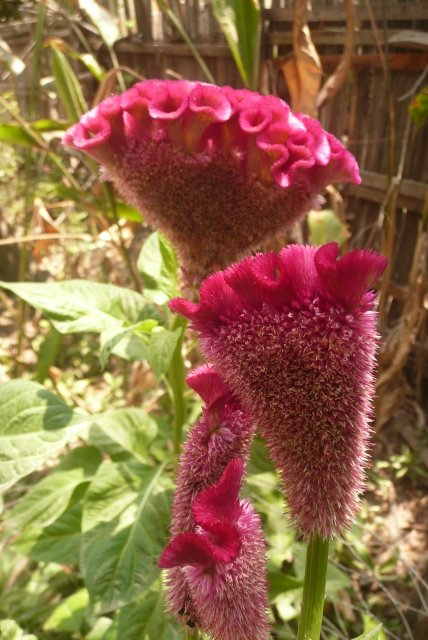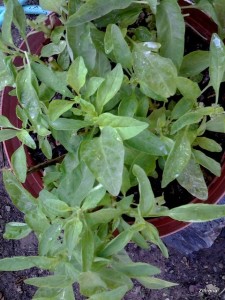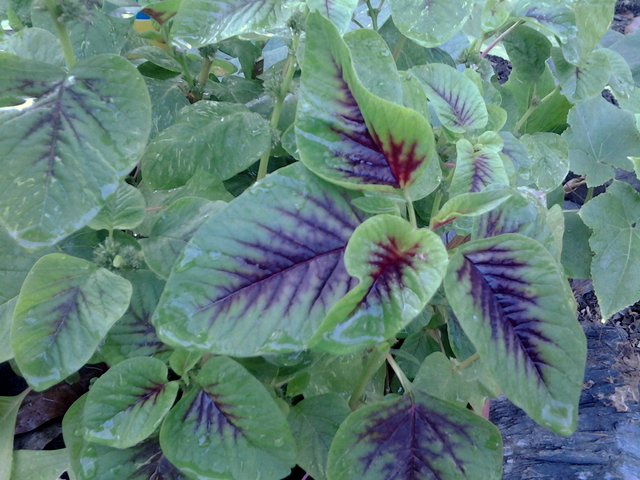Amaranth is awesome! Tropical gardeners, if you want greens (and nutritionally rich seeds) and don’t want to pull your hair out trying to cultivate spinach and lettuce and other more delicate greens in the heat, then try amaranth in any of its seed or vegetable varieties.

Amaranth blossoms
Amaranth loves the heat and is drought resistant. The beautiful plants will provide you with tender shoots that look and taste lovely in salads. They’ll also happily produce larger, deep green and burgundy-colored mature leaves that cook up well as spinach or chard substitutes and will render incredible quantities of edible seeds that can be ground into flour, puffed into cereal, or just cooked as a whole grain.
Flowering amaranths (above) are visually spectacular and produce great quantities of tiny seeds that are easily harvested. Leaf or vegetable amaranths often have small, almost invisible flowers and fewer seeds. They propagate easily and are not prone to plant diseases. Amaranth leaves and seeds are high in calcium and iron; amaranth seeds are also rich in potassium, magnesium, and lysine, an amino acid.

White (edible leaf) amaranth
In Mexico, amaranth seeds are commonly used puffed as a cereal, and can be added with other grains to granola-type mixtures or combined with honey to make candy-like seed bars, somewhat like sesame seed snaps. Amaranth seed candy is known as alegría (joy or happiness) and is a great, protein-rich, not-too-sweet snack food.
In Oaxaca, one of Mexico’s poorest areas, friends Katharine Lorenz and Kate Seely established, in 2003, a non-profit organization with the aim of fighting malnutrition in rural areas. Through Puente a la Salud Comunitaria’s Eco Amaranth program, Lorenz and Seely promote the cultivation and consumption of amaranth, instructing the local women and farmers in the excellent nutritional value of the crop as well as its cultivation and harvest.
Resources:
“Amaranth” is an informational article on the history, uses (food uses, nutritional value, forage uses), growth habits, environment requirements, etc., of amaranth (D.H. Putnam, E.S. Oplinger, J.D. Doll, and E.M. Schulte; Alternative Field Crops Manual, University of Wisconsin-Extension, Cooperative Extension; University of Minnesota: Center for Alternative Plant and Animal Products; and the Minnesota Extension Service; www.hort.purdue.edu/newcrop/afcm/amaranth.html)
A guide to growing amaranth comes from a Tropical Permaculture website article on Growing Amaranth As A Food Plant (www.tropicalpermaculture.com/amaranth-plant.html)
Heirloom Organics has another guide, How to Grow Amaranth (for the Amaranthus hybridus, Red Garnet, seed bearing variety) on the company website. Through that site, you can purchase organic, heirloom, non-hybrid seeds in convenient seed packs.
For yet more valuable information on amazing amaranth, visit the Amaranth Institute, a non-profit organization made up of individuals, companies, and associations involved with the growing, importation, processing, and distribution of amaranth seeds and processed products.

Red Leaf Amaranth, great in salads
Get Amaranth Edible Red Leaf HEIRLOOM Seeds from Botanical Interests
Power Hungry(TM): The Ultimate Energy Bar Cookbook: A cookbook put together by Camilla V. Saulsbury in which she shares her recipes for gluten-free, highly nutritional energy bars that include Cinnamon Cashew Amaranth Bars, Pepita and Popped Amaranth Bars, and Spicy Peanut Amaranth Bars.